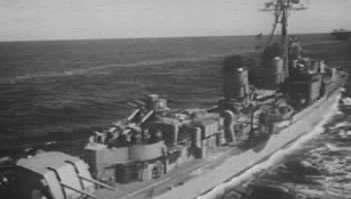The Tonkin Gulf Resolution, 1964
Use this primary source text to explore key historical events.
Suggested Sequencing
- Use this primary source to introduce U.S. involvement in Southeast Asia and the subsequent escalation of involvement via the Vietnam War.
Introduction
After U.S. Navy ships were attacked in the Gulf of Tonkin in 1964, President Lyndon Johnson asked Congress for a resolution expressing “the unity and determination of the United States in supporting freedom and in protecting peace in Southeast Asia.” Although the United States had been involved on a small scale in Southeast Asia since the 1950s in an effort to prevent the spread of communism, the ensuing Gulf of Tonkin Resolution led the nation to send hundreds of thousands of soldiers to Vietnam within a few years. The resolution was passed unanimously in the U.S. House of Representatives and passed the U.S. Senate with only two senators voting against it.
Sourcing Questions
- What explanation was given for the United States to become involved in the conflict in Vietnam in the late 1950s?
- What could be a potential reason why the vote for the Tonkin Gulf Resolution was so overwhelming in the U.S. Congress?
| Vocabulary | Text |
|---|---|
| Joint Resolution | |
| To promote the maintenance of international peace and security in southeast Asia. | |
| deliberately(adv): consciously and intentionally; on purpose | Whereas naval units of the Communist regime in Vietnam, in violation of the principles of the Charter of the United Nations and of international law, have deliberately and repeatedly attacked United States naval vessels lawfully present in international waters, and have thereby created a serious threat to international peace; and |
| systematic(adj): done or acting according to a fixed plan or system; methodical | Whereas these attackers are part of deliberate and systematic campaign of aggression that the Communist regime in North Vietnam has been waging against its neighbors and the nations joined with them in the collective defense of their freedom; and |
| Whereas the United States is assisting the peoples of southeast Asia to protect their freedom and has no territorial, military or political ambitions in that area, but desires only that these people should be left in peace to work out their destinies in their own way. . . | |
| Resolved by the Senate and House of Representatives of the United States of America in Congress assembled, That the Congress approves and supports the determination of the President, as Commander in Chief, to take all necessary measures to repel any armed attack against the forces of the United States and to prevent further aggression. | |
| Section 2. The United States regards as vital to its national interest and to world peace the maintenance of international peace and security in southeast Asia. Consonant with the Constitution of the United States and the Charter of the United Nations and in accordance with its obligations under the Southeast Asia Collective Defense Treaty, the United States is, therefore, prepared, as the President determines, to take all necessary steps, including the use of armed force, to assist any member [Britain, France, Australia, New Zealand, the Philippines, Thailand and Pakistan] or protocol state [South Vietnam, Laos and Cambodia] of the Southeast Asia Collective Defense Treaty requesting assistance in defense of its freedom. | |
| Section 3. This resolution shall expire when the President shall determine that the peace and security of the area is reasonably assured by international conditions created by action of the United Nations or otherwise, except that it may be terminated earlier by concurrent resolution of the Congress. |
Comprehension Questions
- What was the stated purpose of the joint resolution by the U.S. Congress?
- What was the Communist government in North Vietnam accused of violating?
- According to the resolution, what reasons did the United States have for being in the region of southeast Asia?
- What was the U.S. Congress allowing the president to do when the resolution stated “take all necessary measures?” What concern could some people have had about this phrase in the resolution?
- In whose interest was the United States taking this action?
- In what two ways did the resolution expire?
Historical Reasoning Questions
- How did President Johnson come to view the Tonkin Gulf Resolution as an informal declaration of war against North Vietnam?
- What effect did the Tonkin Gulf Resolution have on the later execution of the war by President Johnson?
The Tonkin Gulf Resolution transcript https://www.ourdocuments.gov/doc.php?flash=false&doc=98&page=transcript
